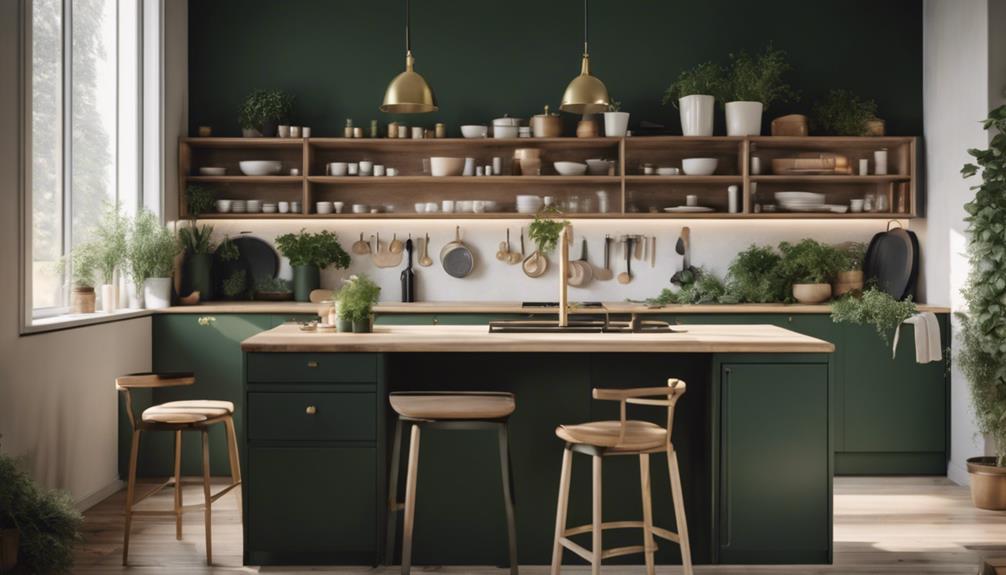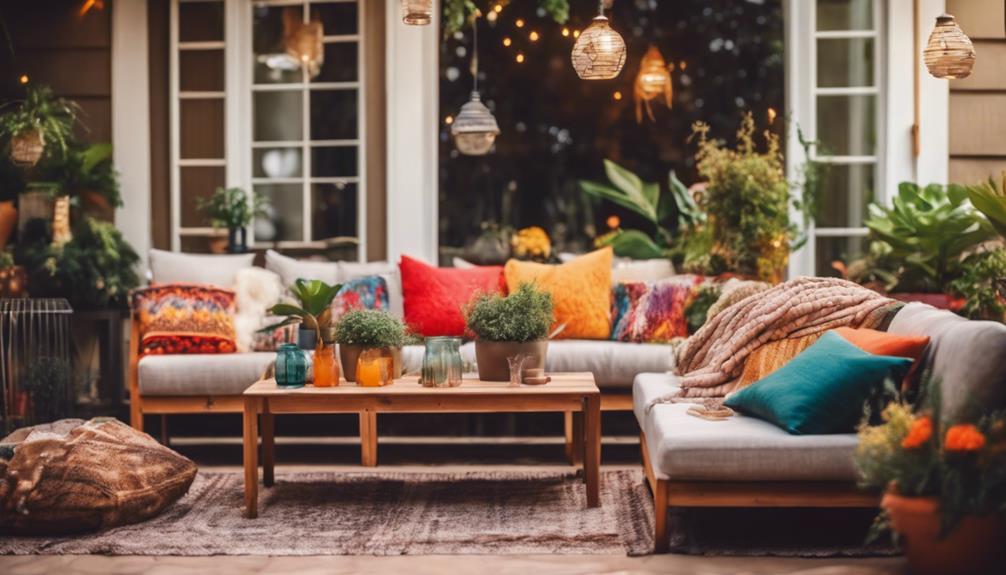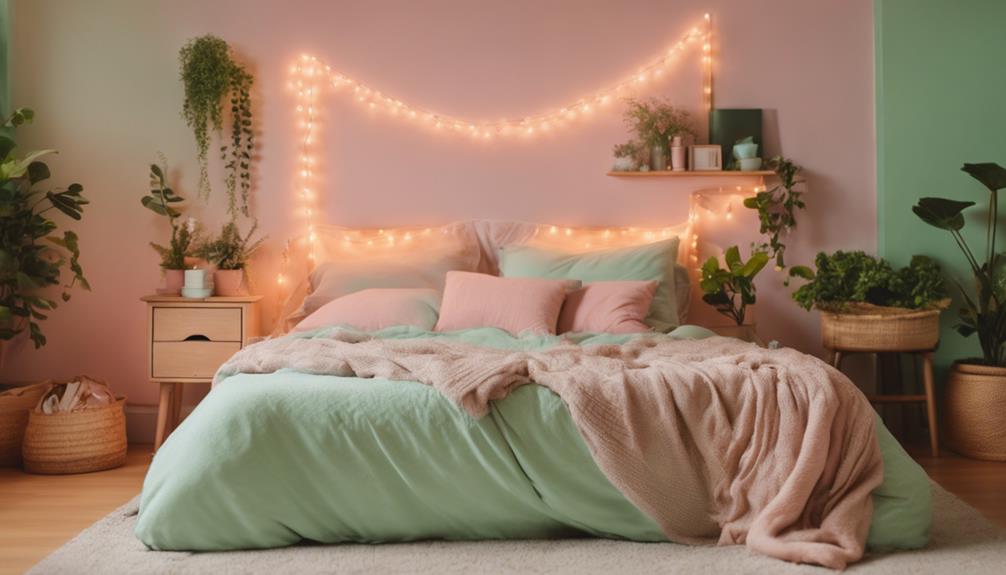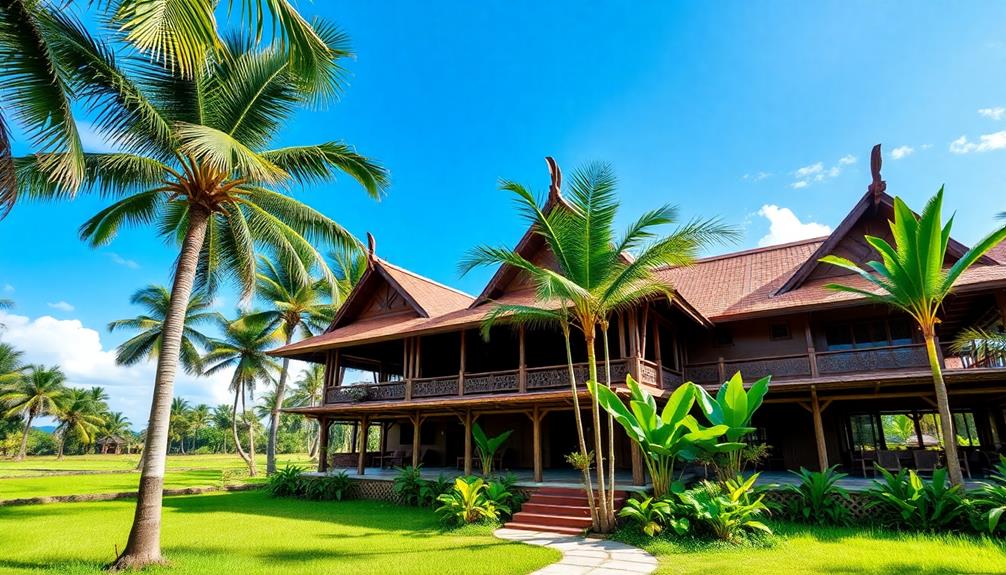Scandinavian kitchen designs can offer so much more than just white. You'll find rich, earthy tones like charcoals and inky blues that add depth while still keeping a clean look. Natural materials, such as light woods and stone, create warmth and texture, enhancing the cozy atmosphere. Incorporate minimalistic lighting fixtures and decorative elements like handcrafted ceramics to add personality without overwhelming the space. Flooring options like light oak or reclaimed barn wood provide durability and charm. If you're curious about creating the perfect balance of beauty and functionality, you're in for some inspiring ideas.
Key Elements
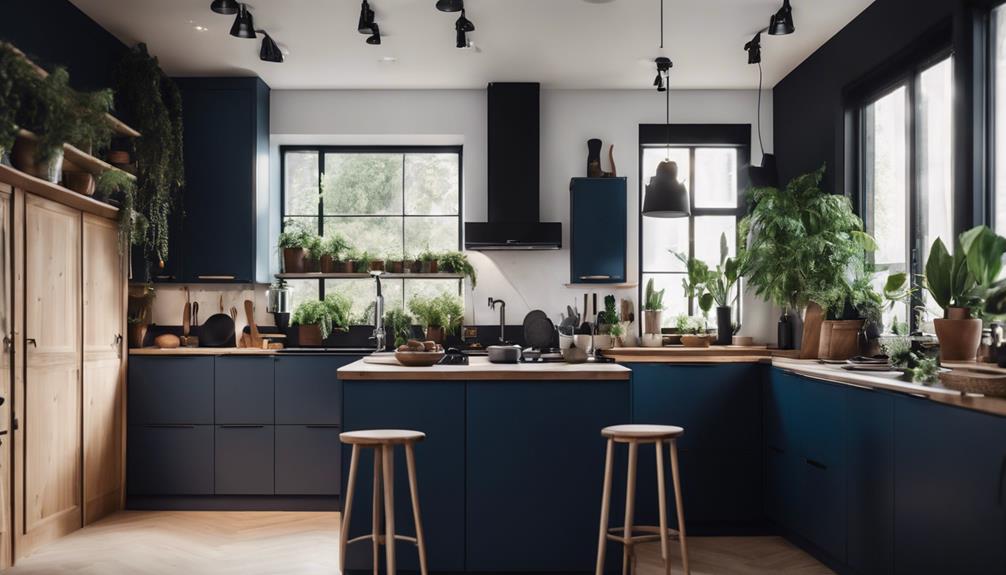
When creating a Scandinavian kitchen, you'll want to focus on the color scheme, materials, and textures that define the style.
Embracing a mix of light and dark tones can add depth, while natural materials like wood and stone bring warmth.
Additionally, incorporating various textures will enhance the overall aesthetic and create an inviting atmosphere.
Color Scheme
Scandinavian kitchen designs embrace a carefully curated color scheme that balances darker hues with light, natural tones to create a harmonious and inviting atmosphere.
You'll find that using a limited palette featuring neutral tones, like whites and grays, alongside earthy tones, such as warm browns and deep greens, achieves a timeless look. These choices reflect the Scandinavian ethos of simplicity and functionality.
Incorporating darker palettes, like charcoals and inky blues, adds depth and contrast while maintaining a clean aesthetic. You can also use accent colors in muted shades—soft greens or blues, for instance—sparingly in cabinetry or decor. This enhances serenity without overwhelming the space.
To elevate your design, consider pairing those neutral tones with colored metals, such as matte black fixtures. This introduces modern elements while complementing the warmth and light of your kitchen.
Seasonal color trends can also play a role; they encourage intentional design choices that evoke comfort and a connection to nature throughout the year.
Materials
A well-designed Scandinavian kitchen incorporates natural materials like stone and wood, enhancing warmth and texture while moving beyond the traditional all-white palette. In addition to natural materials, a Scandinavian kitchen often features clean lines and minimalist design, creating a sense of calm and functionality. To add a touch of warmth and personality, many homeowners are incorporating elements of scandinavian and bohemian interior design into their kitchens, such as colorful textiles, vintage furniture, and eclectic accessories. This blend of styles creates a unique and inviting space that reflects both the simplicity of Scandinavian design and the free-spirited nature of bohemian decor.
You'll find light woods such as beech, ash, and European oak used for cabinetry and furniture, creating a fresh and inviting aesthetic that complements neutral tones. These choices embody the essence of Scandinavian design by promoting a connection to nature.
In addition to wood, you might notice biophilic design elements, like houseplants and organic textiles, which further enrich the space and foster a lively atmosphere. The strategic use of colored metals, such as matte black fixtures, introduces contrast without overwhelming the overall design. This thoughtful balance keeps the kitchen stylish yet functional.
Sustainable materials are a priority in these kitchens, reflecting Nordic values and supporting eco-friendly living. By choosing materials that aren't only beautiful but also sustainable, you contribute to a practical kitchen environment that feels good to live and cook in.
Textures
Incorporating a variety of textures, like warm wood, woven fabrics, and sleek metals, elevates the inviting atmosphere of your kitchen while reflecting Nordic design principles.
In Scandinavian kitchens, natural texture plays an essential role in creating warmth and depth. You can choose light wood tones such as beech, ash, or European oak for furniture and finishes, which enhance that airy feel.
To add contrast, consider using colored metals—matte black taps and light fixtures can provide a striking visual element against the softer wood tones.
Textiles are equally important; think colorful rugs, faded linen napkins, and knitted cushions that not only enhance comfort but also connect to Scandinavian heritage.
For flooring, wooden options are ideal due to their simplicity and comfort, but you might also explore sisal or textured tiles to maintain that natural aesthetic.
Essential Fixtures and Furniture

When designing your Scandinavian kitchen, essential fixtures and furniture play an important role in achieving that minimalist yet inviting look.
You'll want to take into account elements like a Scandinavian-inspired farmhouse sink and pendant light fixtures to enhance both functionality and style.
Additionally, incorporating wall-mounted shelving units can maximize space while keeping the aesthetic clean and organized.
Scandinavian-Inspired Farmhouse Sink
Scandinavian-inspired farmhouse sinks blend durability with aesthetic charm, offering a deep, front-facing design perfect for busy kitchens.
These sinks are crafted from robust materials like fireclay or stainless steel, ensuring they withstand daily wear while looking great. With ample space for washing large pots and pans, they embody the practicality essential in a Scandinavian kitchen design.
One of the standout features of these farmhouse sinks is their color palette. Many come in soft, muted hues like pale gray or sage green, embracing earthy tones that move beyond traditional white. This nod to nature aligns beautifully with the overall Scandinavian ethos of simplicity and warmth.
Additionally, you'll find that accessories like cutting boards and drying racks are designed to fit seamlessly with the farmhouse sink. This enhances functionality while keeping your countertop clutter-free.
Positioned within an open-concept layout, a farmhouse sink becomes a striking focal point, encouraging social interaction as family and friends gather around. In this way, it not only serves a practical purpose but also enhances the inviting atmosphere of your kitchen.
Scandinavian Pendant Light Fixtures
Pendant light fixtures play an essential role in Scandinavian kitchens, combining minimalist design with functionality to enhance both illumination and aesthetic appeal. These pendant lights often feature clean lines and are crafted from materials like metal, glass, and wood, contributing to the modern aesthetic of your minimalist kitchen.
Typically hung over key areas such as kitchen islands and dining tables, they provide focused illumination and elevate the social atmosphere of the space. Popular styles include globes and geometric shapes, often in muted color palettes that complement the neutral tones typical of Scandinavian design.
Incorporating energy-efficient LED technology, these fixtures align with sustainable practices, a hallmark of Nordic design philosophies.
The strategic placement of pendant lights can create a warm and inviting ambiance, essential for the cozy feel associated with Scandinavian interiors, especially during those long winter months.
Scandinavian Wall-Mounted Shelving Unit
Incorporating a Scandinavian wall-mounted shelving unit not only enhances your kitchen's functionality but also complements the minimalist aesthetic established by your pendant light fixtures. These shelving units embody the essence of Scandinavian design with their clean lines and natural wood finishes, creating a harmonious and stylish space.
Designed to provide practical storage solutions, wall-mounted shelving keeps your kitchen organized while maintaining an open and airy feel. You can easily access frequently used items, and they serve as ideal platforms for showcasing decorative pieces or plants, promoting a biophilic design that connects you to nature.
One of the standout features of Scandinavian wall-mounted shelving is its adaptability. Many designs offer adjustable or modular components, allowing you to customize the setup to fit your kitchen layout and personal preferences. Light woods like beech and ash are commonly used, paired with sleek metal brackets in matte black or brass for a modern contrast.
Lighting Ideas
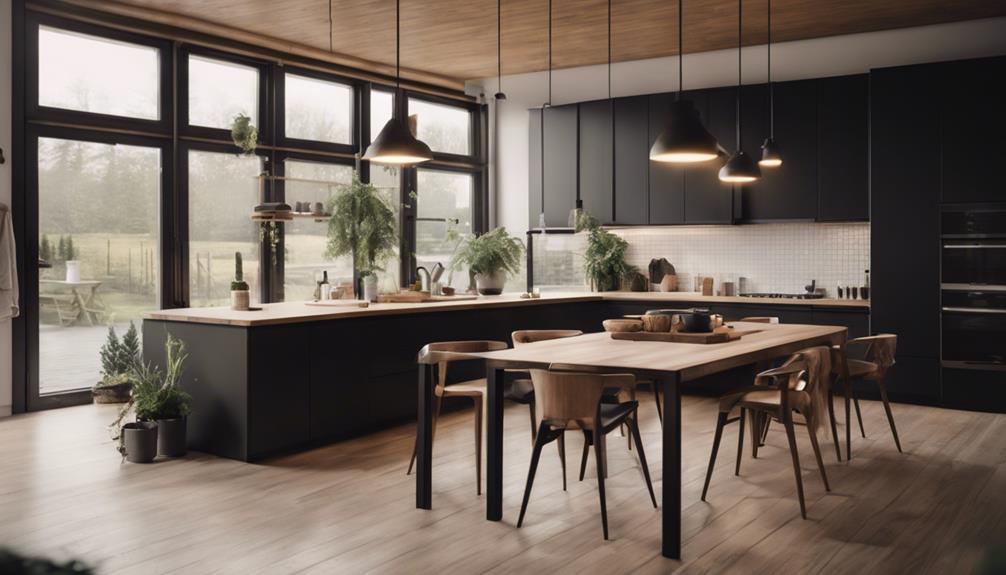
When it comes to lighting in your Scandinavian kitchen, choosing the right fixtures can enhance both functionality and style.
You might consider warm LED strip lighting for a cozy glow, sleek wall sconces for elegance, or natural pendant lights for a touch of organic charm.
Don't forget about candle-inspired table lamps that can add a unique accent while creating a welcoming atmosphere.
Warm LED Strip Lighting
Warm LED strip lighting can transform your Scandinavian kitchen into a cozy haven, making it perfect for both cooking and socializing. Strategically placing these lights under cabinets and shelves enhances the cozy atmosphere typical of Scandinavian design. Not only do they provide functional lighting, but they also create a warm ambiance that invites friends and family to gather.
With adjustable warm LED strip lights, you can easily set different brightness levels. This flexibility allows you to create a welcoming environment during social gatherings or a focused workspace for preparing meals. The color temperature of warm LED lights, typically between 2700K to 3000K, mimics natural sunlight, which is essential in Nordic designs to combat long, dark winters.
Incorporating dimmable warm LED strip lighting adds another layer of comfort, enabling you to adjust the mood according to your needs. You can also use these lights to highlight architectural features and textures in your kitchen, such as wooden cabinets and stone countertops, enhancing the natural materials central to Scandinavian design aesthetics.
Embrace this lighting solution to elevate your kitchen's style and comfort.
Sleek Scandinavian Wall Sconces
Sleek Scandinavian wall sconces enhance your kitchen's ambiance with their minimalist designs and functional elegance. These lights embody the Scandi design ethos, focusing on clean lines and practicality, perfect for creating an airy feel in your space.
You'll find that many of these sconces utilize warm, energy-efficient LED bulbs, which not only provide cozy illumination but also reflect the abundant natural light typical of Nordic style.
When choosing sconces, consider popular materials like brushed metal finishes and natural wood. These options align beautifully with the Scandinavian emphasis on organic elements and sustainability, making them an excellent choice for eco-conscious homeowners.
Adjustable wall sconces are particularly useful, allowing you to direct light over workspaces or dining areas, which is a hallmark of the practical approach favored in Scandinavian kitchens.
Incorporating geometric shapes and soft curves in your wall sconce designs can add a modern touch while still adhering to the simplicity and elegance that define Scandinavian decor.
Natural Pendant Light Fixtures
Natural pendant light fixtures bring a touch of organic elegance to your Scandinavian kitchen, enhancing its inviting atmosphere with their unique textures and minimalist designs. Often crafted from materials like wood, rattan, or bamboo, these fixtures emphasize the warm, cozy ambiance that defines Scandinavian style. Their simple, minimalist designs align perfectly with the functional aesthetics that make this design approach so appealing.
When you opt for larger pendant lights over kitchen islands or dining areas, you create a striking focal point while ensuring essential task lighting for cooking and social interactions. Many natural pendant lights provide soft, diffused lighting that mimics the natural light often lacking during Nordic winters, contributing to a warm and inviting space.
Additionally, consider integrating dimmable features into your pendant lights. This flexibility allows you to adjust brightness levels, catering to both functional tasks during the day and relaxed gatherings in the evening.
Candle-Inspired Table Lamp Designs
Candle-inspired table lamp designs frequently create a cozy ambiance that perfectly complements the minimalist aesthetic of Scandinavian interiors. These lamps often feature soft, warm lighting that mimics the flicker of real candles, enhancing the inviting atmosphere in your home. You'll find many designs crafted from natural wood and glass, aligning with the Scandinavian focus on natural textures and simplicity.
Popular options include lamps shaped like traditional candlesticks, offering a modern twist while maintaining a classic elegance that fits seamlessly into any room. Incorporating LED technology not only adds energy efficiency but also preserves that charming candle-like effect, providing longer-lasting illumination.
These versatile lamps can enhance various settings, whether you place them on dining tables, bedside tables, or in your living room. By choosing candle-inspired table lamp designs, you contribute to the hygge concept of comfort and togetherness that's central to Scandinavian design.
Decorative Elements
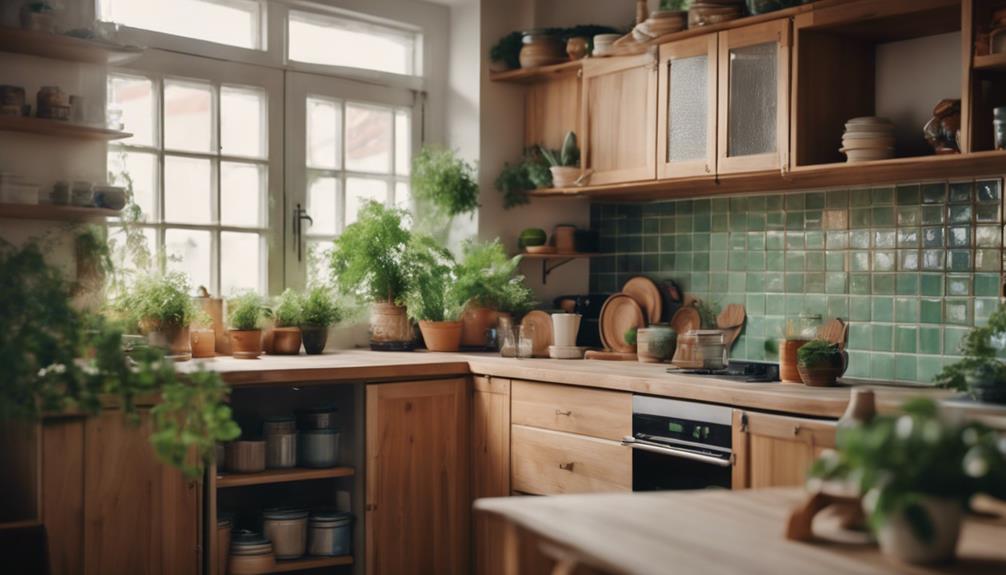
When it comes to decorative elements in a Scandinavian kitchen, you can elevate the space with handcrafted ceramic vases, woven wall hangings, and geometric wall art pieces.
These accents not only enhance the minimalist aesthetic but also add personality and warmth.
Handcrafted Ceramic Vases
Handcrafted ceramic vases add unique organic shapes and textures to Scandinavian kitchen designs, enhancing the minimalist aesthetic with a personal touch. These vases, often made from locally sourced clay, emphasize sustainability while connecting you to nature—one of the core principles of Scandinavian design.
With their muted color palettes of soft grays, earthy browns, and pastel tones, handcrafted ceramic vases align perfectly with the light and airy feel of Scandinavian interiors. You'll find a variety of sizes and shapes, offering versatile styling options. Whether you choose a simple single-flower arrangement or a larger statement piece, these vases can serve as stunning focal points on your countertops or dining tables.
Incorporating handcrafted ceramic vases into your kitchen decor not only adds visual interest but also supports local artisans and traditional craftsmanship. This reflects the Scandinavian ethos of valuing quality and authenticity in your home. By choosing these unique pieces, you create a warm, inviting atmosphere that celebrates both beauty and sustainability, making your kitchen truly distinct.
Woven Wall Hangings
Woven wall hangings bring texture and warmth to your Scandinavian kitchen, enhancing its cozy and inviting atmosphere. These decorative elements often utilize natural fibers like cotton, wool, or jute, reflecting the Scandi look that prioritizes sustainability and organic materials. By incorporating woven wall hangings, you introduce subtle color variations and patterns, breaking up the predominance of white or neutral tones that characterize many Scandinavian designs.
These pieces not only serve as eye-catching accents but also align with the minimalist aesthetic that defines the style. Many woven wall hangings feature geometric designs or organic shapes, contributing to the clean lines and simplicity that are hallmark traits of Nordic design.
Additionally, they can help manage sound in open-concept spaces, acting as natural sound absorbers that create a more serene kitchen environment.
Choosing woven wall hangings allows you to express your personality while adhering to the fundamental principles of Scandinavian design. They add depth and character to your space, making your kitchen not just functional but also a beautiful reflection of your style.
Geometric Wall Art Pieces
Geometric wall art pieces effortlessly enhance your Scandinavian kitchen by incorporating clean lines and minimalist designs that resonate with the style's core principles. These art pieces often feature shapes like triangles, hexagons, and circles, perfectly aligning with the Scandinavian design aesthetic. By utilizing a limited color palette of whites, soft grays, and muted pastels, these artworks create a calming ambiance that's typical in Scandinavian kitchens.
When you strategically place geometric wall art, you can create a focal point that draws attention without overwhelming the simplicity of your space. This balance is essential for maintaining the serene atmosphere that Scandinavian design promotes. Many of these geometric creations are crafted from natural materials such as wood or metal, reinforcing the emphasis on sustainable and organic design elements.
Incorporating geometric patterns into your wall art adds depth and visual interest while adhering to the minimalist principles inherent in Scandinavian aesthetics. By selecting pieces that reflect these characteristics, you not only enhance your kitchen's decor but also stay true to the essence of Scandinavian design, creating a harmonious and inviting environment.
Flooring
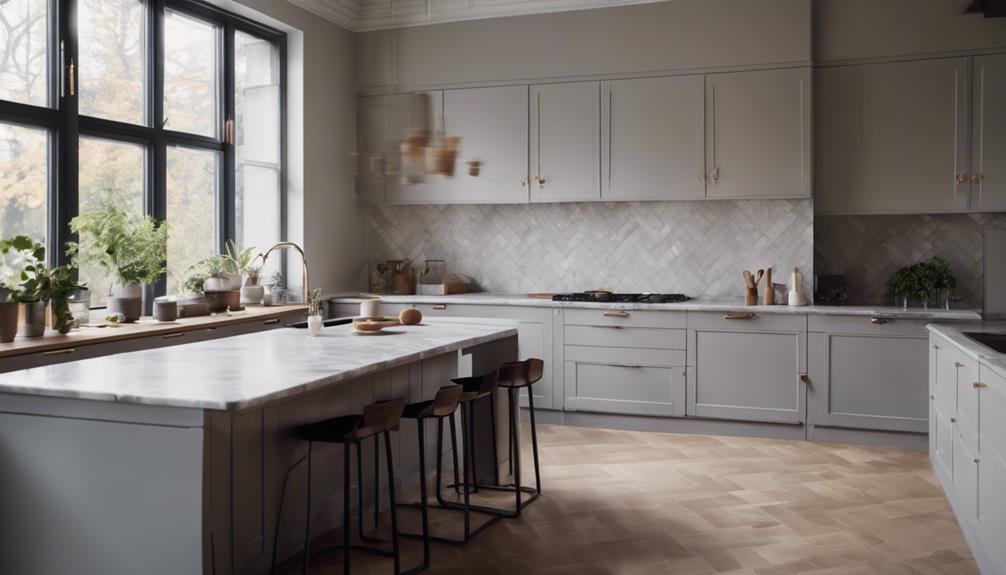
When it comes to flooring in Scandinavian kitchens, you'll want to contemplate options like light oak hardwood, whitewashed pine floorboards, or reclaimed barn wood.
Each choice not only enhances the space's warmth but also aligns with the minimalist and cozy aesthetic typical of Scandi design.
Let's explore how these materials can transform your kitchen into a welcoming haven.
Light Oak Hardwood Flooring
Light oak hardwood flooring brings warmth and a natural aesthetic to Scandinavian kitchens, creating a bright and inviting atmosphere. This light wood option is a popular choice in Scandi kitchens, as it complements the minimalist design ethos while enhancing the overall brightness of the space.
The soft, light coloration of oak effectively maximizes natural light reflection, making your kitchen feel larger and airier, which is especially beneficial in regions with limited daylight.
Durability is another key advantage of light oak wood flooring. Its resistance to wear makes it ideal for high-traffic areas, ensuring that your kitchen remains functional and beautiful over time. The subtle grain patterns and textures of light oak contribute to that cozy yet minimalist vibe characteristic of Scandinavian design, allowing for seamless integration with various decor styles.
Moreover, choosing sustainably sourced light oak aligns with your eco-friendly values, supporting environmental responsibility while enhancing the beauty of your home.
With light oak hardwood flooring, you get a perfect blend of style, durability, and sustainability that embodies the essence of Scandinavian living.
Whitewashed Pine Floorboards
Building on the warmth of light oak hardwood, whitewashed pine floorboards further enhance the inviting atmosphere of Scandinavian kitchens with their bright yet cozy appeal.
This choice of wooden flooring not only brightens your space but also adds a touch of natural texture that complements a white kitchen beautifully. The whitewashing process highlights the grain of the pine, resulting in a soft, matte finish that aligns perfectly with the minimalist aesthetic typical of Nordic kitchen ideas.
Whitewashed pine is durable and resistant to wear, making it ideal for high-traffic areas like the kitchen. Plus, it's easy to maintain, ensuring your flooring stays stunning over time.
This versatile flooring option pairs seamlessly with both light and dark cabinetry, allowing you to create a timeless design that reflects your personal style.
Reclaimed Barn Wood Flooring
Reclaimed barn wood flooring offers a sustainable and unique choice that infuses Scandinavian kitchens with warmth and character. By choosing reclaimed barn wood, you're embracing eco-friendly materials that not only enhance your kitchen's aesthetic but also contribute to a more sustainable lifestyle. Each plank carries its own history, showcasing unique textures and colors that add depth to your design.
This flooring option stands up to the demands of a busy kitchen, thanks to its durability, making it a practical choice for any home. You can finish reclaimed barn wood in various ways to align with the minimalist principles of Scandinavian kitchen designs, providing a rustic contrast to sleek cabinetry and modern appliances.
Incorporating this type of flooring into your kitchen supports the biophilic design concept, linking your interior space to nature. The natural materials evoke a sense of the outdoors, creating a serene and inviting atmosphere. By choosing reclaimed barn wood flooring, you're not just enhancing your kitchen's beauty; you're also making a conscious effort toward sustainability and a deeper connection with nature.
Conclusion
Embracing Scandinavian kitchen designs doesn't have to mean sticking to white.
By incorporating bold colors, natural materials, and unique fixtures, you can create a warm and inviting space that reflects your personal style.
Don't forget to play with lighting and decorative elements to enhance the atmosphere further.
With thoughtful choices in flooring and furniture, your kitchen can blend functionality and aesthetics, making it a true heart of your home.
So go ahead, get creative and make it yours!
